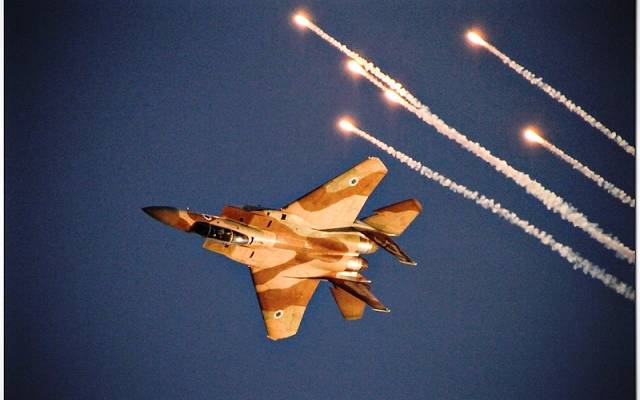“Trust us. We are standing watch over the walls and ensuring quiet. And maybe also deterring those who watch us from the side,” an IAF commander declared.
By: Yaakov Lappin, JNS.org
Minutes before his fighter jets took off to take part in a historic flyby marking Israel’s 70th year of Independence, the commander of the 101 Squadron of the Israeli Air Force told JNS that he viewed the event as an important mission—one that carries a powerful message.
“It’s a special feeling to take part in this,” Lt.-Col. “A” (full name withheld), whose squadron consists of F-16 aircraft, said. “It’s not so trivial for pilots to do something that is aimed at exhibiting their activity, in a visible way. We are used to doing our work without many people knowing about it, and we prefer it that way. This is a different kind of mission.”
Every type of IAF combat aircraft took part in the flyby, encircling most of the country and passing over the majority of the population.
Squadron 101 is the first Israeli combat air formation (and is therefore dubbed the First Fighter Squadron). Like the State of Israel, it, too, is marking its 70th year. A day earlier, the squadron took part in a flyby for Yom Hazikaron, Israel’s Memorial Day for Fallen Soldiers, in honor of fallen air force personnel.
Lt.-Col. “A” said being able to mark historic events this way is a “big privilege,” adding that the squadron’s personnel felt a little “positive tension” to get the job done in the best possible manner, knowing that large crowds are watching them from down below.
“We usually do not do something to be seen. We usually act so that the population experiences quiet, not to deliver a show of force. If, once in a while, like today’s 70th Independence Day, we do something to be seen—to transmit the message that there is a strong air force and military that knows what needs to be done, that takes responsibility and guards what needs to be guarded—if this message is sent in a modest and clear way, then this is perhaps what we’re aiming to achieve,” he added.
At the same time, the squadron commander stressed that the flyby was not an overblown attempt to show off force. “As I briefed my personnel, and as the other squadrons perceive it, it’s a simple statement that we are here, that we take our mission very seriously . . . and that as in the rest of the year, we work so that civilians have quiet and security. Here, too, the message is: Trust us. We are standing watch over the walls and ensuring quiet. And maybe also deterring those who watch us from the side, and who know that it is not advisable to test us.”
In the first Independence Day flyby event of its kind, international air forces from Greece, Italy, Austria, Poland, the United Kingdom and Canada took part.
F-16 fighter jets from Greece’s Hellenic Air Force were just taking off from the 101 Squadron’s air base of Hatzor, near the coastal Israeli city of Ashdod, as Lt.-Col. “A” spoke to JNS.
“In general, cooperation with other air forces, and in particular, with the Greek Air Force has become very common in recent years,” he said. “Our joint work is good. Generally, when pilots and squadrons talk to each other, they very quickly discover the same common language, and it is very easy to get to the bottom line.”
The Hellenic Air Force easily blended into the flyby’s stages, and the pre-flight briefings and planning enabled the air forces to all be on the same page, he added.
The Naval Perspective
The Israeli Navy also played a prominent role in Independence Day festivities, sending missile ships and submarines to cruise across the Israeli coastline, and opening up its bases to the general public.
Lt.-Col. Ofer David, commander of the Red Sea Arena in the Israeli Navy, said that the naval base in Eilat, at the tip of the Jewish state, opened its doors to the public for the first time in seven years. Missile ships from Haifa Base, naval commando units, an underwater search unit and the Israel Police’s naval units all took part in exhibitions, as did the Border Police and the Israel Police.
It was the widest naval display in Eilat to date, noted David. Visitors who came saw the latest naval technology for themselves.
Speaking about the Red Sea Arena’s day-to-day routine, he said: “We protect the whole of the Eilat bay area safeguarding naval sovereignty. Our objective is to prevent terrorism from entering, and enabling all residents and visitors to enjoy this amazing bay, and give them a sense of calm, so that they can have fun and focus on their leisure activities and sail in the waters, as we stand guard.”
The navy has, in recent years, dealt with “quite a few incidents,” said the commander. “Some were stopped in time, and some were stopped right before they started. We investigate and understand what the enemy is preparing, [and] we innovate to stay a step ahead of the enemy, and our finger is on the intelligence pulse.”
The IDF’s ground forces, meanwhile, held a large-scale airborne operational drill, with soldiers parachuting to the ground in three different areas: in Tel Aviv, Haifa and near the Sea of Galilee.
The IDF estimated that some 350,000 citizens visited bases across the country throughout the holiday.
